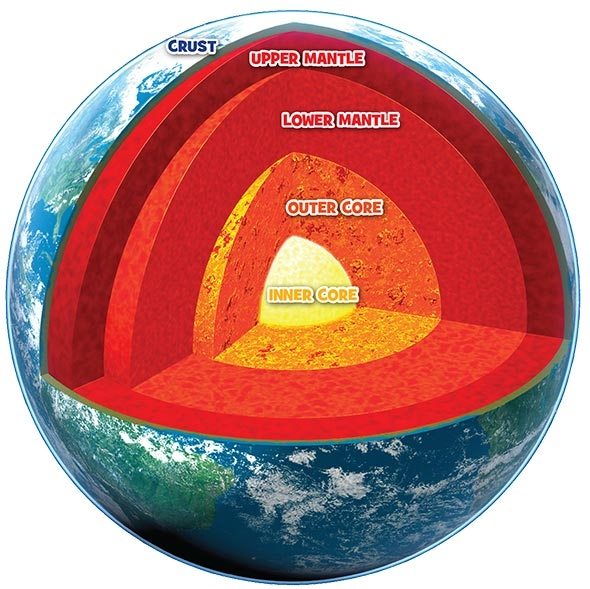The Earth's crust is divided into seven major tectonic plates, with about 20 tectonic plates in total. These plates fit together like the pieces of a jigsaw puzzle. The plates move very slowly around Earth's surface, powered by the planet's inner heat. Along the edges of the plates, the crust is constantly being destroyed or new crust created. These processes are the cause of most of the world's earthquakes and volcanoes.
|
Crust
Temperature: Around 22°C State: Solid Composition: Oceanic crust made up of iron, oxygen, silicon, magnesium and aluminium. Continental crust made up of granite, sedimentary rocks and metamorphic rocks. The Earth’s surface is covered by its thinnest layer, the crust. Land is made of continental crust, which is 8km to 70km thick and made mostly from a rock called granite. The layer beneath the ocean bed is made of oceanic crust, which is about 8km thick and made mainly from a rock called basalt. Upper Mantle
Temperature: 1,400°C – 3,000°C State: liquid / solid Composition: iron, oxygen, silicon, magnesium and aluminium This layer is up to 670km below the Earth’s surface. The lower part of the upper mantle is made from both solid and melted rock (liquid), while the rock in the upper region is stiffer, because it’s cooler. Lower Mantle
Temperature: 3,000°C State: solid Composition: iron, oxygen, silicon, magnesium and aluminium The lower mantle is found between 670km and 2,890km below the surface, and is made from solid rock. The rock is hot enough to melt, but is solid because of the pressure pushing down on it. Outer Core
Temperature: 4,000°C – 6,000°C State: Liquid Composition: iron, nickel, sulphur and oxygen This liquid layer of iron and nickel is 5,150km deep. The outer core flows around the centre of the Earth, and the movement of the metals creates our planet’s magnetic field. Inner Core
Temperature: 5,000°C – 6,000°C State: Solid Composition: iron and nickel The Earth’s inner core is a huge metal ball, 2,500km wide. Made mainly of iron, the temperature of the ball is 5,000°C to 6,000°C – that’s up to 6,000 times hotter than our atmosphere and scorching enough to make metal melt! The metal at the inner core stays solid because of the incredible pressure surrounding it. |
